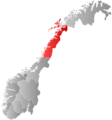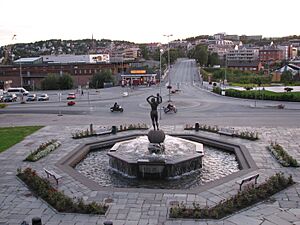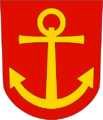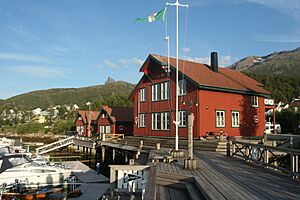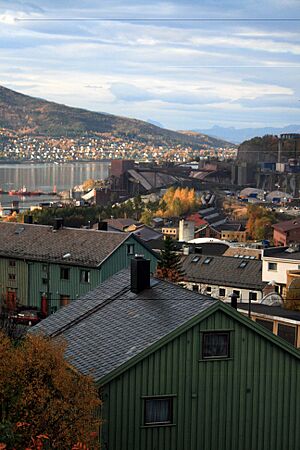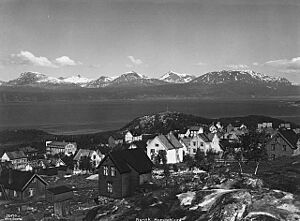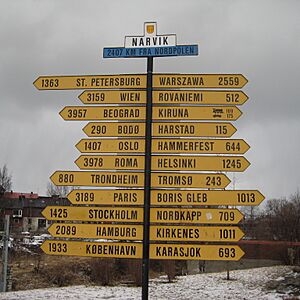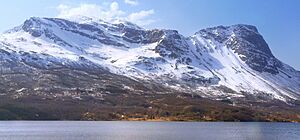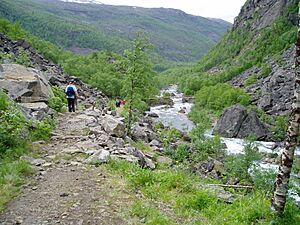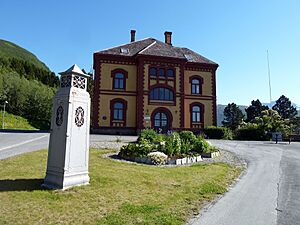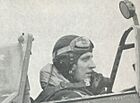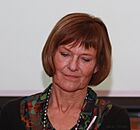Narvik Municipality facts for kids
Quick facts for kids
Narvik kommune
Áhkanjárga (Northern Sami) |
|||||
|---|---|---|---|---|---|
|
Municipality
|
|||||
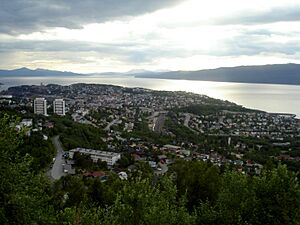
View of Narvik
|
|||||
|
|||||
| Nicknames:
By1
|
|||||

Narvik within Nordland
|
|||||
| Country | Norway | ||||
| County | Nordland | ||||
| District | Ofoten | ||||
| Established | 1 Jan 1902 | ||||
| Administrative centre | Narvik | ||||
| Area | |||||
| • Total | 3,432.20 km2 (1,325.18 sq mi) | ||||
| • Land | 3,194.70 km2 (1,233.48 sq mi) | ||||
| • Water | 237.50 km2 (91.70 sq mi) 6.9% | ||||
| Area rank | #10 in Norway | ||||
| Population
(2024)
|
|||||
| • Total | 21,580 | ||||
| • Rank | #61 in Norway | ||||
| • Density | 6.3/km2 (16/sq mi) | ||||
| • Change (10 years) | 15.4% | ||||
| Demonyms | Narvikværing Narviking |
||||
| Time zone | UTC+01:00 (CET) | ||||
| • Summer (DST) | UTC+02:00 (CEST) | ||||
| ISO 3166 code | NO-1806 | ||||
| Official language form | Neutral | ||||
| Preceded by | Ankenes Municipality | ||||
|
|
|||||
Narvik (also known as Northern Sami: Áhkanjárga in Sami) is a large municipality in Nordland county, Norway. It is the third-largest municipality in Nordland by population. The main town and administrative center is Narvik.
Narvik is located on the shores of the Ofotfjorden, a long and deep fjord. It is part of the traditional district of Ofoten in Northern Norway. The municipality is found inside the Arctic Circle. Narvik borders other municipalities in Norway and also Sweden to the south and east.
Narvik is the 10th largest municipality in Norway by area, covering about 3,432 square kilometers. It is home to 21,580 people, making it the 61st most populated municipality in Norway. The number of people living here has grown by 15.4% in the last 10 years.
Contents
About Narvik: A Growing Municipality
The municipality of Narvik started on 1 January 1902. Back then, the village of Narvik became a proper town, called a kjøpstad. It separated from the larger Ankenes Municipality. At first, the town of Narvik had 3,705 residents.
Over the years, Narvik grew bigger by joining with nearby areas. On 1 January 1974, Ankenes Municipality merged with Narvik. This made the new Narvik Municipality much larger, with 19,780 residents.
Later, on 1 January 2020, Narvik Municipality merged again. This time, it joined with Ballangen Municipality and part of Tysfjord Municipality. This created the even larger Narvik Municipality we know today.
Narvik's Coat of Arms
A coat of arms is a special symbol for a city or family. Narvik has a new coat of arms that started being used on 1 January 2020. It has a blue background with a white mountain peak. This mountain looks like Stetind, a famous local mountain. The artist who designed it was Eirik Djupvik.
Before 2020, Narvik had a different coat of arms. It had a red background with a gold anchor. The anchor showed that Narvik is an important port city. It has the largest harbor in North Norway. This older design was made by Hallvard Trætteberg.
What Does "Narvik" Mean?
The name "Narvik" comes from an old farm called Narvik. The town was built on this farm. The name might come from two Old Norse words.
One idea is from Knarravík, meaning "merchant ship inlet". This would mean it was a place where trading ships came. The other idea is from Njarðarvík. This name comes from an old Norse god named Njǫrðr. Both ideas share the last part, vík, which means "inlet" or "bay".
Long ago, the harbor in Narvik was called Victoriahavn. This name honored Queen Victoria of the United Kingdom. It also honored Sweden's Crown Princess Victoria.
Narvik's Rich History
People have lived in the Narvik area since the Bronze Age. We don't know much about these early people. But we do know that Vikings lived here a long time ago.
Modern Narvik grew because of Swedish iron ore mines. These mines were in Kiruna and Gällivare, Sweden. The problem was getting the iron ore out to the world. Sweden's port, Luleå, would freeze in winter. It also wasn't deep enough for big ships.
Narvik offered a perfect solution. Its port is ice-free all year, thanks to the warm Gulf Stream. It is also naturally deep, allowing very large ships to dock. So, a railway line was built to connect the Swedish mines to Narvik. This railway is called the Iron Ore Line in Sweden and the Ofotbanen in Norway.
Today, the Swedish mining company LKAB still ships a lot of its ore from Narvik. About 25 million tons of ore are shipped each year. This makes LKAB an important employer in Narvik.
Narvik During World War II
Narvik's port became very important during World War II. In 1939, Germany needed iron ore from Sweden for its war factories. In winter, the Baltic Sea froze, so the ore had to go through Narvik. From Narvik, it was shipped down the coast of Norway to Germany.
Winston Churchill, the British leader, knew this. He realized that controlling Narvik could stop Germany's iron ore supply in winter. This could help the Allies win the war faster. Also, later in the war, German submarines based in Narvik could threaten Allied supply lines.
On 8 April 1940, Britain tried to lay mines around Narvik. The next day, Germany invaded Norway. Ten German destroyers with soldiers arrived in Narvik. The Norwegian ships HNoMS Eidsvold and HNoMS Norge tried to fight but were sunk. The British Royal Navy quickly sent ships, including the battleship HMS Warspite. During the Battles of Narvik, the British destroyed the German destroyers.
Allied soldiers from Norway, France, Poland, and Britain fought together. They recaptured Narvik on 28 May 1940. This was the first Allied infantry victory in World War II. However, the Allies were losing the Battle of France at the same time. They needed their soldiers elsewhere. So, the Allies left Narvik on 8 June 1940.
Without Allied support, the Norwegian forces were outnumbered. They had to stop fighting on 10 June 1940. But they continued to fight in small guerrilla groups inland. Narvik's deep fjord was also important for German warships. It gave them a safe place away from air attacks.
Narvik's Natural Beauty and Climate
Narvik Municipality is very large and includes much natural land. Besides the town, there are other small settlements like Bjerkvik and Beisfjord. The eastern part, near Sweden, has many tall mountains. The highest point is Storsteinfjellet, which is 1,893.7 meters tall. The mountain Stetinden is also very famous.
Narvik has many beautiful valleys and lakes. Some of the lakes include Baugevatnet and Gautelisvatnet. The town of Narvik sits at the end of the deep Ofotfjorden. Mountains rise steeply from the blue fjord, reaching up to 1,700 meters. You can even see the Frostisen glacier in Skjomen.
Forests grow on the lower parts of the mountains, below 500 meters. But near the tops, snow can stay for most of the summer. Narvik is known for its great alpine skiing slopes. Some of these slopes end almost in the town center!
Narvik's Unique Climate
Narvik has a cool climate, but it is very mild for being so far north. It is about 220 kilometers inside the Arctic Circle. The mountains around the town protect it from strong coastal winds.
The light changes a lot in Narvik throughout the year. From late November to mid-January, the sun stays below the horizon. During this time, there are only a few hours of bluish light around noon. The mountains make this period feel even longer, from early November to late January.
In March and April, the light becomes very bright. There are long hours of daylight. Snow melts in the lowlands in April, but it stays in the mountains for months. The "midnight sun" shines from 25 May to 20 July. This means the sun never fully sets during this time. The period of continuous daylight lasts even longer, from about 10 May to the end of July.
| Climate data for Narvik Airport 1991–2020 (31 m, precipitation Narvik III, extremes 1954-2020 includes earlier stations) | |||||||||||||
|---|---|---|---|---|---|---|---|---|---|---|---|---|---|
| Month | Jan | Feb | Mar | Apr | May | Jun | Jul | Aug | Sep | Oct | Nov | Dec | Year |
| Record high °C (°F) | 11.5 (52.7) |
9 (48) |
12.5 (54.5) |
20.4 (68.7) |
29.9 (85.8) |
30 (86) |
32.5 (90.5) |
28.6 (83.5) |
27.2 (81.0) |
19.6 (67.3) |
15.8 (60.4) |
11.4 (52.5) |
32.5 (90.5) |
| Daily mean °C (°F) | −2.3 (27.9) |
−2.7 (27.1) |
−0.8 (30.6) |
2.9 (37.2) |
7.4 (45.3) |
11.4 (52.5) |
14.5 (58.1) |
13.5 (56.3) |
9.4 (48.9) |
4.5 (40.1) |
1.2 (34.2) |
−0.8 (30.6) |
4.9 (40.7) |
| Record low °C (°F) | −20 (−4) |
−22.3 (−8.1) |
−15.7 (3.7) |
−11.8 (10.8) |
−5 (23) |
−1 (30) |
4.5 (40.1) |
0.5 (32.9) |
−3.5 (25.7) |
−11.1 (12.0) |
−13.6 (7.5) |
−19 (−2) |
−22.3 (−8.1) |
| Average precipitation mm (inches) | 108 (4.3) |
98 (3.9) |
82 (3.2) |
44 (1.7) |
56 (2.2) |
57 (2.2) |
88 (3.5) |
91 (3.6) |
107 (4.2) |
107 (4.2) |
99 (3.9) |
97 (3.8) |
1,034 (40.7) |
| Source: Norwegian Meteorological Institute | |||||||||||||
| Climate data for Narvik (1961–90) | |||||||||||||
|---|---|---|---|---|---|---|---|---|---|---|---|---|---|
| Month | Jan | Feb | Mar | Apr | May | Jun | Jul | Aug | Sep | Oct | Nov | Dec | Year |
| Mean daily maximum °C (°F) | −2 (28) |
−2 (28) |
1 (34) |
5 (41) |
9 (48) |
14 (57) |
18 (64) |
16 (61) |
12 (54) |
6 (43) |
3 (37) |
−1 (30) |
7 (44) |
| Daily mean °C (°F) | −4.1 (24.6) |
−3.9 (25.0) |
−2 (28) |
1.8 (35.2) |
6.9 (44.4) |
10.9 (51.6) |
13.4 (56.1) |
12.5 (54.5) |
8.4 (47.1) |
4.2 (39.6) |
−0.2 (31.6) |
−2.7 (27.1) |
3.8 (38.8) |
| Mean daily minimum °C (°F) | −7 (19) |
−7 (19) |
−5 (23) |
−2 (28) |
3 (37) |
7 (45) |
11 (52) |
10 (50) |
6 (43) |
2 (36) |
−2 (28) |
−5 (23) |
1 (34) |
| Average precipitation mm (inches) | 69 (2.7) |
64 (2.5) |
49 (1.9) |
44 (1.7) |
40 (1.6) |
53 (2.1) |
74 (2.9) |
82 (3.2) |
92 (3.6) |
110 (4.3) |
75 (3.0) |
78 (3.1) |
830 (32.7) |
| Average precipitation days (≥ 1mm) | 10.6 | 10.2 | 8.8 | 9.1 | 9.2 | 12.4 | 14.7 | 14.0 | 15.1 | 14.5 | 11.1 | 12.2 | 141.9 |
| Source: Norwegian Meteorological Institute – eKlima portal | |||||||||||||
Economy and Fun in Narvik
The town of Narvik is a busy center for business. It serves the whole municipality and some nearby areas. Narvik University College is here, with about 1,200 students. Narvik also has some high-tech companies. The largest research center in Northern Norway, Norut Narvik, is also located here.
Things to Do and See
Narvik offers many outdoor activities. It is famous in northern Norway for alpine skiing. There are ski lifts and floodlit slopes. You can also take a cable car up to Fagernesfjellet. From there, you get amazing views and can hike even higher.
The Narvik Winter Festival (Vinterfestuka) happens every year in early March. Mountain hiking is very popular. There are places to stay in the mountain areas near the Swedish border. You can also find a special route for mountain biking.
Many people enjoy wreck diving in Narvik. There are many shipwrecks in and near the harbor. Fishing in the fjord or in lakes and streams is also a favorite pastime. You can find salmon rivers in areas like Skjomen and Beisfjord.
Getting Around Narvik
Narvik is a key spot for transportation in Northern Norway. The Ofotfjord cuts deep into the land. This leaves only a few kilometers between the fjord and the border with Sweden. The main highway, European route E6, runs through Narvik. The Port of Narvik is also a very important hub for shipping goods.
Train Travel in Narvik
The Ofoten Line railway is very important for Narvik. It connects northern Sweden across the mountains to this port town. Goods like iron ore are shipped using this railway. This makes Narvik a major seaport. The railway has stops at Bjørnfjell Station and Narvik Station.
Because of the tough mountains, there are no railways directly north or south in Norway from Narvik. However, you can reach Narvik by train from Stockholm, Sweden. This journey takes about twenty hours and covers 1,540 kilometers.
The railway and large port are still very important for Narvik. Goods for North Norway, Sweden, and Finland often pass through Narvik. There are even plans to use Narvik as a port for goods from East Asia going to North America. This route would be shorter than going through central Europe.
Air Travel in Narvik
Narvik is served by Harstad/Narvik Airport, Evenes. This airport is about 57 kilometers from Narvik by road. It has regular flights to major Norwegian cities. These include Oslo, Trondheim, Bodø, and Tromsø.
Narvik's Culture and People
The Narvik War Museum (Narvik Krigsmuseum) teaches about the war years from 1940 to 1945. The museum shows a Victoria Cross, a very brave award. It also has a rare German Enigma machine, which was used for secret codes.
Museum Nord - Narvik tells the story of Narvik's growth. It shows how the ice-free harbor developed. It also explains how the town changed quickly over the last century. The museum building itself was built in 1902. It was once the main office for the Norwegian state railway company.
Churches in Narvik
The Church of Norway has four parishes in Narvik Municipality. These are part of the Ofoten prosti (a church district).
| Parish (sokn) | Church Name | Location of the Church | Year Built |
|---|---|---|---|
| Ankenes | Ankenes Church | Ankenesstrand | 1867 |
| Håkvik Chapel | Håkvik | 1980 | |
| Bjerkvik | Bjerkvik Church | Bjerkvik | 1955 |
| Bjørnfjell Chapel | Bjørnfjell | 1952 | |
| Narvik | Narvik Church | Narvik | 1925 |
| Fredskapellet | Narvik | 1957 | |
| Hergot Chapel | Hergot | 2005 | |
| Skjomen | Skjomen Church | Elvegården | 1893 |
Famous People from Narvik
Many notable people have come from Narvik. Here are a few:
- Theodor Broch (1904–1998): A lawyer and politician who was Mayor of Narvik for many years.
- Helge Mehre (1911–1997): A brave Norwegian military officer.
- Fredrik Kiil (1921–2015): A doctor who made important improvements to the artificial kidney.
- Cissi Klein (1929 in Narvik – 1943 in Auschwitz): A young Norwegian-Jewish girl who was a victim of the Holocaust.
- Dr. Jan Paulsen (born 1935): A leader in the Seventh-day Adventist Church.
- Jack Berntsen (1940–2010): A linguist, songwriter, and folk singer.
- Thorgeir Stubø (1943–1986): A jazz musician and composer.
- Terje Bjørklund (born 1945): A jazz pianist and composer.
- Gro Brækken (born 1952): A businesswoman who has led several public groups.
- Lise Haavik (born 1962): A Danish-Norwegian singer who sang at the 1986 Eurovision Song Contest.
- Anne Rydning (born 1965): A Colonel in the Norwegian army and the first female Army chief in Afghanistan.
- Vibeke Larsen (born 1971 in Vassdalen): A Norwegian-Sami politician.
Sports Stars from Narvik
- Per Willy Guttormsen (born 1942): A speed skater who competed in three Winter Olympics.
- Thomas Hafstad (born 1974): A retired football player who played many games for Tromsø IL.
- Ragnhild Gulbrandsen (born 1977): A journalist and former football striker for the Norwegian national team.
- Marit Røsberg Jacobsen (born 1994): A talented handball player.
Narvik's Sister Cities
Narvik is twinned with several cities around the world. These partnerships help build friendships and understanding between different cultures.




